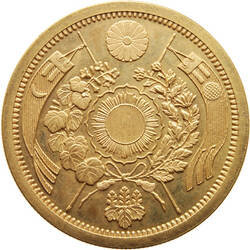The dragon featured on the obverse of this 20 yen coin is thought to symbolise the power of the Japanese imperial dynasty. The sun, the kiri flower and the chrysanthemum, shown here on the reverse, are also closely linked with the emperor, or tenno. Emperor Mutsuhito had this coin minted in 1880.
He reigned from 1867 until his death in 1912. For Japan, this was a time of radical transformation. The country had only fairly recently given in to international pressure and opened its borders after centuries of self-imposed isolation. As a result, rigid social structures were becoming more flexible, but social tensions were growing. Japan had previously been ruled by the Shogun. After he resigned in 1868, the samurai warrior caste lost ground politically. Emperor Mutsuhito came to power with a programme of reforms he called "Meiji", which translates as "enlightened rule". He modernised his backward country gradually – and successfully. Soon, Japan was the equal of the powerful states of Europe.
Right at the beginning of his reign, he reformed the currency system along European lines. He introduced gold and silver yen coins in 1870, followed two years later by the first banknotes denominated in yen.
Further Media
- Location & Dating
- Japan, 13th year of reign (1880)
- Material & Technique
- gold, embossed
- Dimenions
- Diameter: 35,0 mm; weight: 33,338 g
- Museum
- Münzkabinett
- Inventory number
- AXA3413
